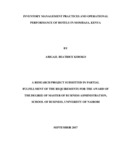| dc.description.abstract | Inventory management is the responsibility of the entire organization and it is very critical to hotel success. The study sought to establish the inventory management practices used by hotels in Mombasa, Kenya, to determine the relationship between inventory management practices and operational performance of hotels in Mombasa Kenya and to determine the challenges faced when implementing inventory management practices in hotels in Mombasa Kenya. The study used descriptive survey and the population for this study comprised 3star, 4 star and 5 star hotels in Mombasa Kenya considered 37 hotels. Out of 37 questionnaires distributed, 34 were filled and successfully returned for analysis. This represented 92 percent response rate, which was considered sufficient for making generalization of all the hotels in Mombasa. To analyze the data Descriptive statistics and regression analysis were used. FIFO was the most inventory management practice used in hotels in Mombasa Kenya, while marginal analysis, ERP, EOQ model, just in time and VMI were used to a large extent and ABC Analysis and stochastic model were moderately used and RFIS was used to a very small extent. The regression results observed that Stochastic model, FIFO, EOQ Model, ABC Analysis, RFIS, VMI, Just In Time and marginal analysis were statistically not significant since their probability values obtained from the regression model were above 0.05 and z critical value were below 1.96, their p-values are 0.710, 0 .905, 0 .702, 0.146, 0.696, 0.405 and 0.464 respectively. On the other hand ERP was statistically significant since the p-value was less than 5%, p=0.006. The regression model was found to be insignificant since the P value = 0.173 was greater than 5%. This implied that the predictor variables did not provide significant level of explanation of the relationship between inventory management practices and operational performance of hotels in Mombasa Kenya. Further the study concludes that the major challenge faced by hotels in Mombasa Kenya in the implementation of inventory management practice was lack of proper training. Incompetent staffs, failure to invest in modern technologies, unreliable suppliers and poor record keeping were other challenges facing the hotels in Mombasa Kenya to a moderate extent. Lack of commitment by top management was a challenge to a very small extent. The major limitation of the study was limited to hotels in Mombasa Kenya only due to costs and time constraints. It would have been important for future researchers to consider researching on inventory management practices and operational performance in hotels in Kwale, Kilifi, Lamu, Taita Taveta counties to find out whether these findings stand out. The study recommends that the hotels should put more emphasis on creating forums to train and equip their concerned staff with skills of inventory management. | en_US |



